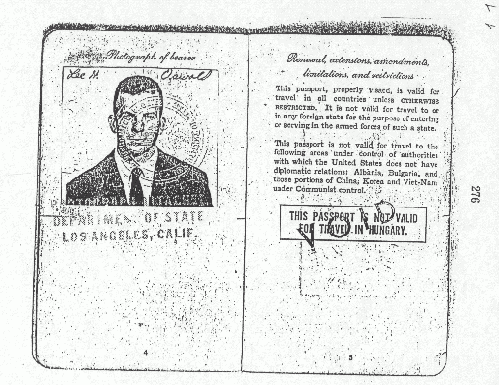Scott focuses on the importance of these anomalies that fill Oswald's CIA file, stating that they are evidence of "a significant, sophisticated multi-agency counterintelligence operation." Scott advances the thesis that "Oswald himself was a low-level part of a CI search for a leak or mole", and that Oswald's unexplained talk of espionage right in front of the KGB microphones (the KGB had the US embassy thoroughly bugged) is a very poor way to convince the KGB of his bona fides but "makes perfect sense as a test for leaks in response to Popov's arrest fifteen days earlier".
The American and Soviet embassies have long and famous histories for placing bugs in each other's embassies, tapping each other's phones, and reading each other's mail. The KGB confirmed in 1959 that Freers was not CIA, and that the KGB maintained a microphone in Freers' office.
Angleton told the Church Committee that the role of CI/SIG was to prevent the penetration of spies into the CIA and the government, and that the "historical penetration cases are recruitment of U.S. officials in positions (of) code clerks." Angleton's search for a mole turned the CIA upside down by the time he was fired in 1974. Dozens of CIA officers were fired. By 1980, Congress was forced to pass a "Mole Relief Act" to compensate the unfairly accused victims.
Egerter used Oswald himself in what is called a "dangle". Angleton's biographer Tom Mangold wrote that the execution of Popov accelerated Angleton's belief that "Popov could only have been betrayed by a mole buried deep within Soviet Division.". Mangold found Angleton misguided, stating that "Popov was actually lost to the Soviets because of a slipshod CIA operation; there was no treachery." David Robarge, in a very thoughtful piece that should be read in its entirety, agrees that Popov's capture marked the time when Angleton became "fixed on the mole". Oswald's arrival was on the same date as Popov's arrest.
Nonetheless, if Angleton was convinced that there was a mole in the Soviet Division, it's a good bet that he believed that radar operator Oswald's sudden entry into the Soviet Union on the same day was no accident.
What is curious is that Egerter opened no 201 file for Oswald at this point. A 201 file is a CIA file that is created to profile any person "of active operational interest". For whatever reason, she did not want to admit that the CIA had any operational interest in Oswald.
The FBI had operational interest in Oswald, and let everybody know it. Headquarters supervisor Marvin Gheesling is described as having "considerable experience in espionage, intelligence and counterintelligence operations." Gheesling, legend maker #6 , promptly opened a "watch list" file on Oswald within a week of his visit to the Embassy in late 1959 by creating what is called a FLASH card. As John Newman muses, "This combination of being on the Watch List without a 201 file makes Oswald special. Perhaps not unique, but certainly peculiar. It was as if someone wanted Oswald watched quietly."
At the same time, Oswald was added to the HT LINGUAL list, Angleton was effectively in charge of HT LINGUAL, a joint project of the CIA, FBI and US Postal Service in which Angleton was the titular head. Oswald was now one of the 300 Americans whose letters would be secretly opened as part of HT LINGUAL project monitoring mail coming from the USSR.
A quick glance at what happened three years later: Gheesling's role turned ominous when he took Oswald off the watch list in the month before the assassination. Gheesling's action took place just hours before Egerter helped write two separate messages that provided two different descriptions of Oswald. One message sent to third party agencies referred to him specifically as "Lee Henry Oswald", with an inaccurate physical description, apparently designed to mislead the national leadership of these agencies. The in-house message provided a more accurate description of Oswald - as we'll see later, still containing subtle mistakes - going only to the local agencies. These are further indications of the molehunt.
Gheesling's decision to take Oswald off the watch list effectively dimmed the lights around Oswald. It meant that Oswald would not be watched in Dallas with close scrutiny in situations involving national security, such as when JFK came to town in a motorcade. If Gheesling had waited another day, Oswald would have been in the spotlight. Dallas agents would have been on him like white on rice.
After Egerter passes Oswald's marked cards to FBI's John Fain, Fain joins the molehunt
Going back to 1960...the marked cards begin to multiply a few months later. In February 1960, Oswald's mother is worrying about him. Marguerite told the Secret Service that SA John Fain recommends that she write Secretary of State Christian Herter and Congressmen Sam Rayburn and Jim Wright. Curiously, the FBI has no public paper trail of meeting with Fain at this early date. FBI files in 1959-60 and Oswald's Marine records remain classified and should be released.
Mrs. Oswald then sends one letter to Congressman Wright telling him that "according to the UPI Moscow press, he appeared at the US embassy renouncing his citizenship". The next day, she wrote Secretary Herter a letter saying that Oswald had not renounced his citizenship and "is still a U.S. citizen".
Why Mrs. Oswald would say two different things in two different letters one day apart is a longer discussion. Nonetheless, these two totally contradictory documents are a central part of this case. The inaccurate statement that Oswald had "renounced his citizenship" was central to SA Fain's report of May 12, 1960. This report also had the marked card of "Edward Lee Oswald" for the name of Oswald's deceased father, rather than his correct name of Robert Edward Lee Oswald.
(Note: You can view every article as one long page if you sign up as an Advocate Member, or higher).





